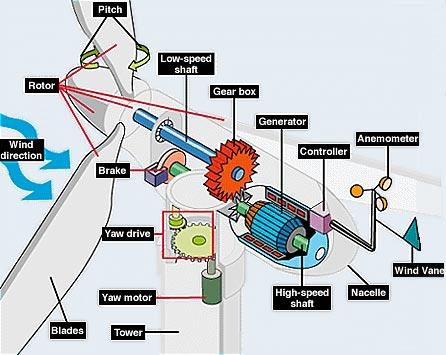Breeze Turbines
Wind is induced by uneven heating of the planet earth from the sunshine making wind a free and renewable source of power. Blowing wind turbines are a different supply of power which harnesses this particular renewable wind energy to produce an electric current. Because wind turbines operate entirely on wind, they result in absolutely no pollution producing them earth friendly. Essentially, the wind turns blades which are linked to a turbine, the turbine subsequently generates electrical power (more on this later). You will find 2 primary kinds of wind turbines, vertical and horizontal axis. A wind generator applicable for urban settings had also been studied. Almost all 3 kinds of wind turbines have different designs, disadvantages and different advantages and.
Horizontal axis wind turbines
Horizontal axis wind turbines would be the most frequent category used (see figure one). Many of the elements (cutters, shaft, generator) are atop a tall tower, as well as the blades face into the wind power. The shaft is horizontal on the soil. The cutting blades on the turbine which are linked to some shaft leading to rotation are hit by the wind. The shaft features a gear on the conclusion and that turns a generator. Electricity is produced by the generator and directs the electrical energy into the power system. The wind generator also offers several crucial components which contribute to efficiency. Inside the Nacelle (or maybe head) happens to be an anemometer, wind vane, then controller which examine the pace and direction of the blowing wind. As the blowing wind changes direction, an engine (yaw motor) spins the nacelle and so the wiper blades will always be dealing with the blowing wind. The energy source, in addition, includes a security feature. Just in case of extraordinary winds the turbine has a pause which will impede the shaft speed. This's inhibiting some harm to the turbine in conditions that are extraordinary.
Advantages
• Blades are on the edge of the center of the turbine of gravity, assisting stability
• Capability towing warp, giving the turbine blades perfect perspective of attack
• Capability to pitch the rotor cutters inside a storm to reduce damage
• The tall tower allows the use of much stronger wind in websites with wind shear
• Tall tower enables placement on an irregular area and in offshore locations
• Is usually sited in the forest above tree-line
• Most are self-starting
Disadvantages
• Difficulty running in near ground winds
• Hard to carry (twenty % of devices costs)
• Hard to set up (require skilled operators) and tall cranes
• Effect radar in proximity
• Local opponent to aesthetics
• Difficult maintenance
Vertical axis
In vertical axis turbines the shaft the wiper blades are linked to is vertical to the soil (see figure two). All the primary elements are near the soil. Furthermore, the wind generator is close to the floor, unlike horizontal where things are for a tower. You will find 2 kinds of vertical axis wind turbines; lift primarily based and also drag based. Lift based styles are typically a lot more effective compared to drag, or' paddle' styles.Figure two: Vertical axis wind turbine (lift type)
Advantages
• Easy to maintain
• Lower transportation and building costs
• Not directional
• Best at mesas, ridgelines, and hilltops passes
Disadvantages
• Blades regularly whirling back again into the wind triggering drag
• Less efficient
• Operate in reduced, much more turbulent wind
• Low starting torque plus could require power to begin turning
Ducted Wind Turbines
Ducted wind turbines are placed at the advantage of the top of construction and also use the airflow along a building's edge. The air moves upwards, hugging the construction structure then goes into the front side of the duct. Turbine blade diameter is generally around 600 mm. The products are fairly little making a small visible effect on the construction. They're placed over construction as shown in figure three below.
Advantages
• Less visible effect on buildings architecture than standard VAWT or HAWT turbines
• Use seldom used roof space in cities
• Allows power should be greeted on site staying away from transmission losses related to centralized energy generation
Disadvantages
• Ideal for urban spaces, however, not households (only efficient on urban high rise buildings) • Unidirectional. Fixed position plus are reliant upon wind blowing in the appropriate direction
• More advancement and research is required. Investigation in this particular area is developing as individuals start to be far more enthusiastic about citified wind generation.
• Research needs to be performed to establish energy production potential


Comments
Post a Comment